Mad Hedge Bitcoin Letter
October 14, 2021
Fiat Lux
Featured Trade:
(WHAT’S NEW IN BIOTECH)
(CGTX), (BIIB), (LLY), (ABBV), (NVS), (TAK), (PYXS), (PFE),
(AZN), (GILD), (GSK), (IMGN), (ISO), (TMO), (BIO)

Mad Hedge Bitcoin Letter
October 14, 2021
Fiat Lux
Featured Trade:
(WHAT’S NEW IN BIOTECH)
(CGTX), (BIIB), (LLY), (ABBV), (NVS), (TAK), (PYXS), (PFE),
(AZN), (GILD), (GSK), (IMGN), (ISO), (TMO), (BIO)

As the biotechnology world is ever-evolving, with several companies going public every few months, let me share some of the most promising names that recently emerged.
The first is Cognition Therapeutics (CGTX), a company working on treatments for Alzheimer’s disease and macular degeneration.
Its most promising candidate is an Alzheimer’s treatment called CT1812, which is currently under Phase 2 trials. Looking at the timeline, CGTX expects to release topline data by 2023.
With the expected growth of the aging population, focusing on treating various forms of Alzheimer’s is a promising direction for Cognition Therapeutics.
In fact, the global market for this neurodegenerative disease is projected to grow from $2.9 billion in 2018 to a whopping $10.5 billion by 2025.
So far, the major competitors of Cognition Therapeutics in this area include Biogen (BIIB), Eli Lilly (LLY), AbbVie (ABBV), Novartis (NVS), and Takeda (TAK).
The second promising biotech company is Pyxis Oncology (PYXS), which is a spinoff from Pfizer (PFE).
Pyxis is focused on developing next-generation treatments targeting difficult-to-treat types of cancer.
Basically, the company’s goal is to create therapies that can directly kill tumor cells. It also wants to get rid of the underlying problems that lead to the uncontrollable spread of tumors and the weakening of the immune system.
To do this, Pyxis has come up with novel antibody drug conjugate (ACT) candidates and other monoclonal antibody (mAb) pipelines.
Its lead candidate is called ADC PYX-201, a potential treatment for non-small cell lung cancer and breast cancer.
The goal of ADC PYX-201 is to target actively multiplying tumors while boosting the immune response of the patient’s body. Pyxis plans to submit it as a non-small cell lung cancer treatment candidate by mid-2022.
If approved, then ADC PYX-201 will be under patent protection until 2037.
This holds great potential for Pyxis’ cashflow, as the market for non-small cell lung cancer worldwide is anticipated to rise from $6.2 billion in 2016 to over $12 billion by 2025.
With this potential of ADC treatments, Pyxis can expect competition from the likes of AstraZeneca (AZN), Gilead Sciences (GILD), GlaxoSmithKline (GSK), and ImmunoGen (IMGN).
The last name on today’s list is IsoPlexis Corporation (ISO).
This company is the first to focus on dynamic proteomics and single-cell biology in an effort to develop “walk-away automation” products that aid in shortening the therapeutic development timelines by acquiring “multiplexed proteomics with very low sample volumes that reflect in vivo biology to clarify lead candidates.”
In layman’s terms, IsoPlexis is working on a technology that aims to identify every protein in the body to speed up the development of new therapies for rare diseases.
This is a lucrative business, with IsoPlexis targeting at least $34 billion in the total addressable market.
Considering that IsoPlexis is a pioneer in this field, it is possible for it to gain the lion’s share of the segment and position itself as an undisputed leader for years.
More importantly, IsoPlexis can use its patented technology, “Proteomic Barcoded,” to expand the use cases to cover other lucrative markets.
For example, IsoPlexis can apply its technology to cancer immunology and targeted oncology by predicting the progression of cancer cells in the body.
Adding cell therapies to the company’s pipeline is also a very realistic possibility since its technology can be utilized to create CAR-T cell therapies as well.
In fact, IsoPlexis’ approach is already being used in developing treatments for leukemia and melanoma.
Another profitable avenue for IsoPlexis’ technology is the vaccines sector.
Since the development of vaccines requires profiling the responses of the respiratory and immune systems, the company’s data would accelerate the entire process.
So far, the major rivals of IsoPlexis in this space include Thermo Fisher Scientific (TMO) and Bio Rad Laboratories (BIO).
While all these biotech companies offer promising products and technologies, they’re all still in the early stages of development.
This makes them high-risk investments and are likely suitable for those who are willing to invest in the long term.
For those who want to see movement faster and sooner, it might be best to watch these stocks from the sidelines.
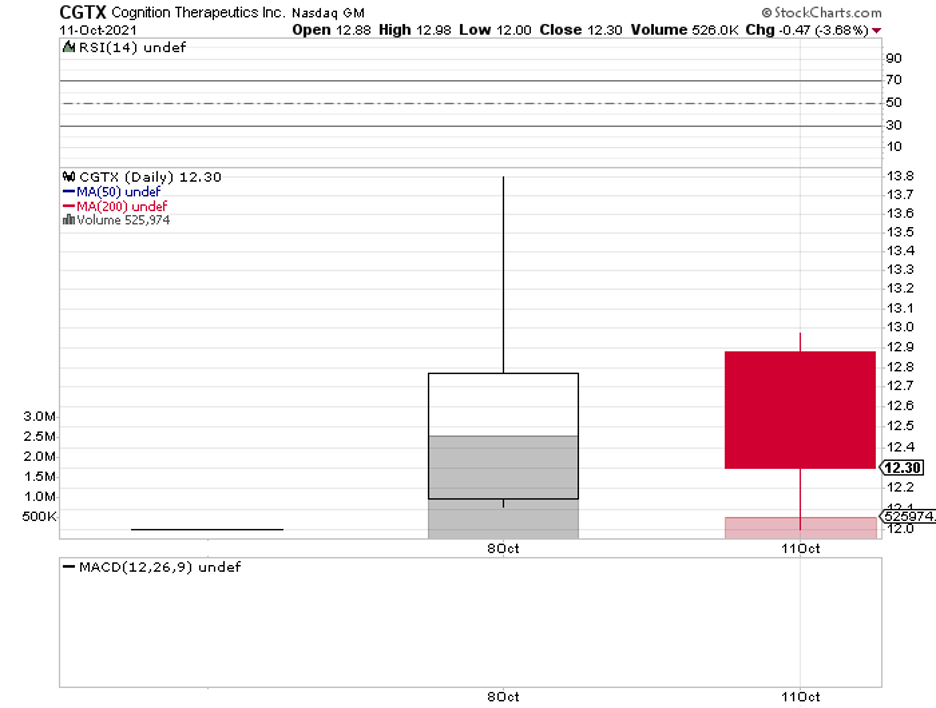
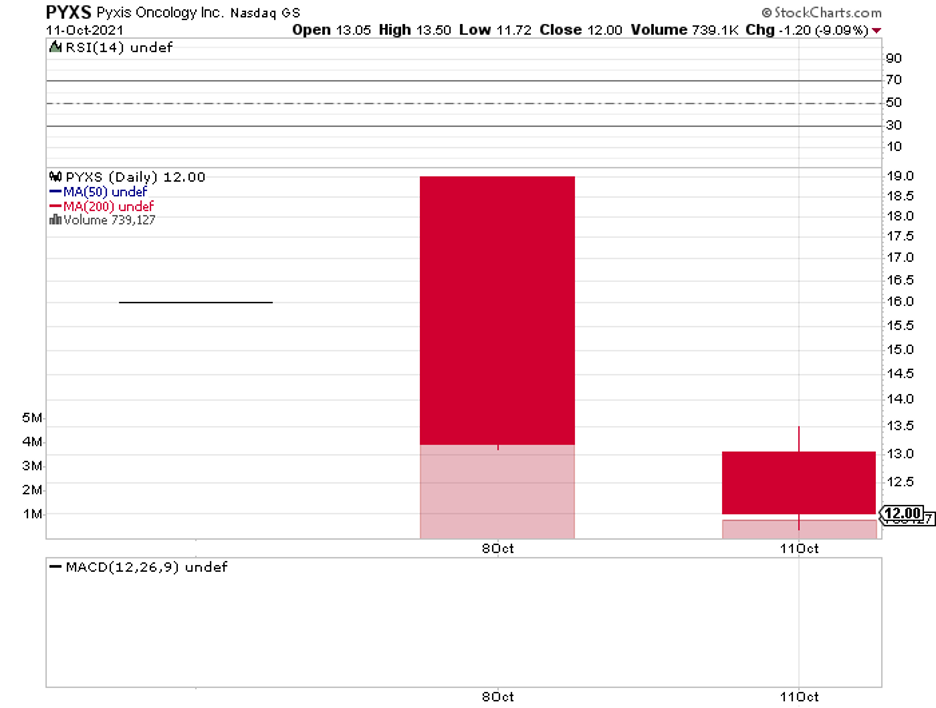
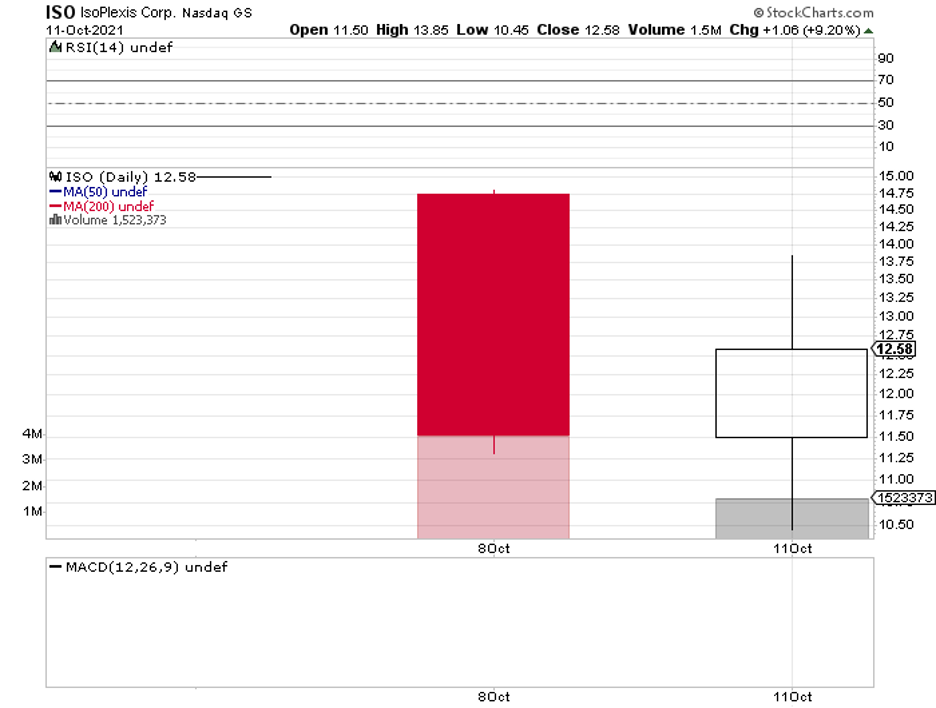
Mad Hedge Biotech & Healthcare Letter
September 2, 2021
Fiat Lux
FEATURED TRADE:
(BIOTECHS ARE OUT FOR BLOOD)
(BIIB), (LLY), (BAYRY), (NVS), (SNY)

Tracing its origins in Greek mythology to the infamous Dracula tales, stories centered on the restorative powers of blood have captivated our imagination for millennia.
In the past two decades, however, the concept of hailing blood as the elixir of youth has come a long way from ancient folklore.
These days, this idea has reached the medical world with highly renowned researchers throwing their names behind the study of the regenerative ability of young blood.
From mere storybook fantasies, this concept has become one of the serious contenders alongside the likes of Biogen (BIIB), Eli Lilly (LLY), and Bayer (BAYRY) in the fight against Alzheimer’s, Parkinson’s, and even stroke.
Here’s a quick explanation for this change.
At its core, one of the major causes of aging is when our systems go on overdrive in the performance of usual bodily functions.
That is, the body shifts away from the “regular” state or homeostasis and instead is forced to constantly be in alert mode.
This causes us to end up with a hyper pro-inflammatory immune system, which then malfunctions and results in damaged tissues and organs over time, exposing the body to diseases and conditions like neurodegeneration and heart attacks.
The solution is quite simple. Let’s just flush out those pro-inflammatory aging compounds—aka the overworked system. That way, we can delay (or probably even prevent) the aging process.
This can be done through a process called “parabiosis,” which has only been experimented on mice.
Basically, this works by connecting the circulatory system of an older mouse to a younger one. Then, the older mouse starts to get younger as well.
In 2005, researchers published a paper that studied two identical mice (one old and one young) to demonstrate the veracity of the concept.
To test the idea, they connected the circulatory systems of both mice. This means that the two lived off the same general blood pool, which comprises young and old blood.
In just 5 weeks, the older mouse’s stem cells started to divide again. Its muscles and liver cells also began to repair themselves.
Essentially, from a cellular viewpoint, the older mouse transformed into a younger version of itself.
Given the medical, moral, and ethical issues that come with the traditional “parabiosis,” biotechnology companies have searched for more efficient and effective ways to achieve these age-defying results other than the vampiric blood swap.
But, how can these results be replicated?
This is where “Total Plasma Exchange” (TPE) comes in.
TPE is done using an apheresis machine. The patient’s blood runs through this device, which then removes and discards filtered plasma via the reinfusion of red blood cells as well as other replacement fluids, including plasma or albumin.
Without going through the technical nitty-gritty, TPE involves the extraction of a large volume of blood from a patient, taking it apart into its individual components, then returning it to the same patient’s body sans the filtered-out components courtesy of the machine.
Recently, clinical trials on humans showed that TPE managed to slow disease progression among patients suffering from age-related disorders, like Alzheimer’s, by more than 66%.
While there’s no uniform cost for this treatment, the average estimate for every TPE session is roughly $101,140. Just how much this would cost in the long run heavily depends on the person’s condition and desired outcome.
At this point, the research is still in its early stages.
However, this hasn’t prevented rogue biohackers from testing out their own theories—and come up with surprisingly workable results.
In 2020, two 50-year-old self-confessed “biohackers” based in Russia hooked themselves up to blood collection machines. They then proceeded to replace practically half of the plasma coursing through their own veins with salty water.
After 3 days, their blood tests showed an improvement in their general well-being, as seen in their hormones, fats, and other indicators.
In particular, their immunity, cholesterol metabolism, and even liver function showed better performance.
So far, this concept has been explored by other researchers who are now replacing plasma with saline and adding other components like albumin.
These experiments are still being conducted on animals, but they have to date proven to be promising in terms of reducing inflammation in the brain and improving cognitive functions.
Primarily, the Russian biohackers and these experts are diluting the anti-aging factors to slow down or even eventually prevent aging.
Among the probable applications of plasma in the anti-aging movement, the dilution process seems to be the easiest and most convenient track to pursue—so much so that a company, called IMYu, was founded by top UC Berkley researchers to develop this strategy further.
Thus far, only a handful of biotechs have focused on this concept.
Some of the frontrunners are Massachusetts-based Elevian, which was founded in 2017, and Alkahest, which was acquired by Spanish pharmaceutical giant Grifols (GRF) for $146 million.
Meanwhile, a company called Nugenics Research has actually patented the name “Elixir” for its plasma-derived product under development.
There are also clinics like the Atlantis Anti-Aging Institute based in Florida and companies such as Ambrosia, which market plasma gathered from donors ages 16 to 25 and sell them for several thousand dollars for every transfusion.
Thus far, big pharma has yet to get its hands on this technology.
Only a handful of major companies, including Novartis (NVS) and Sanofi (SNY), have expressed interest in exploring these possibilities.
However, these innovations are only a glimpse of the incredible momentum driving the anti-aging industry these days.
It’s only a matter of time until we achieve a spectacularly extended lifespan with an impressively high quality of health and wellbeing.
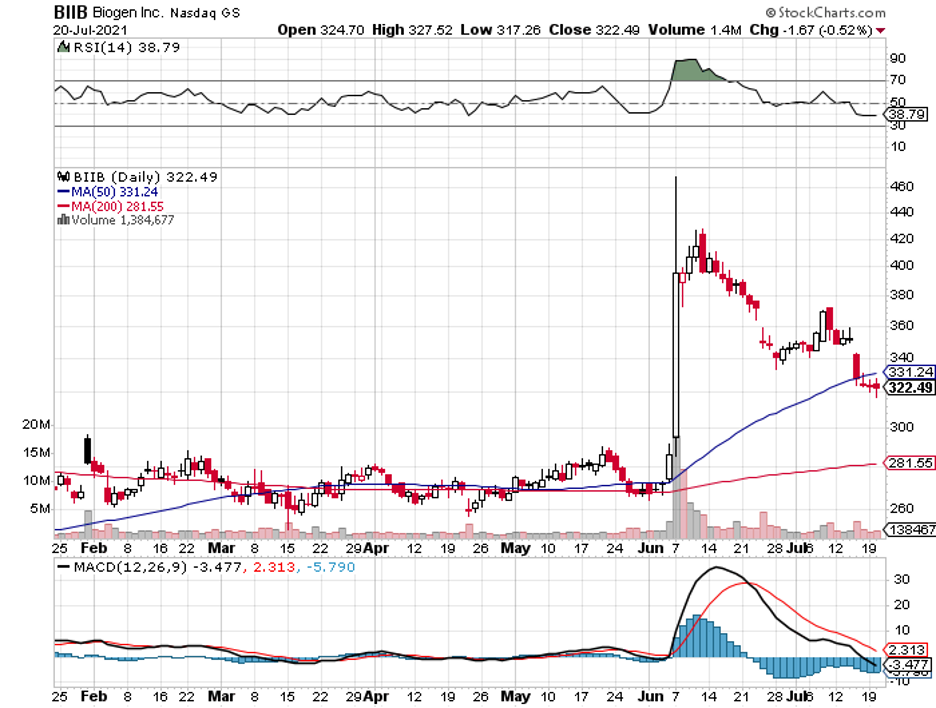
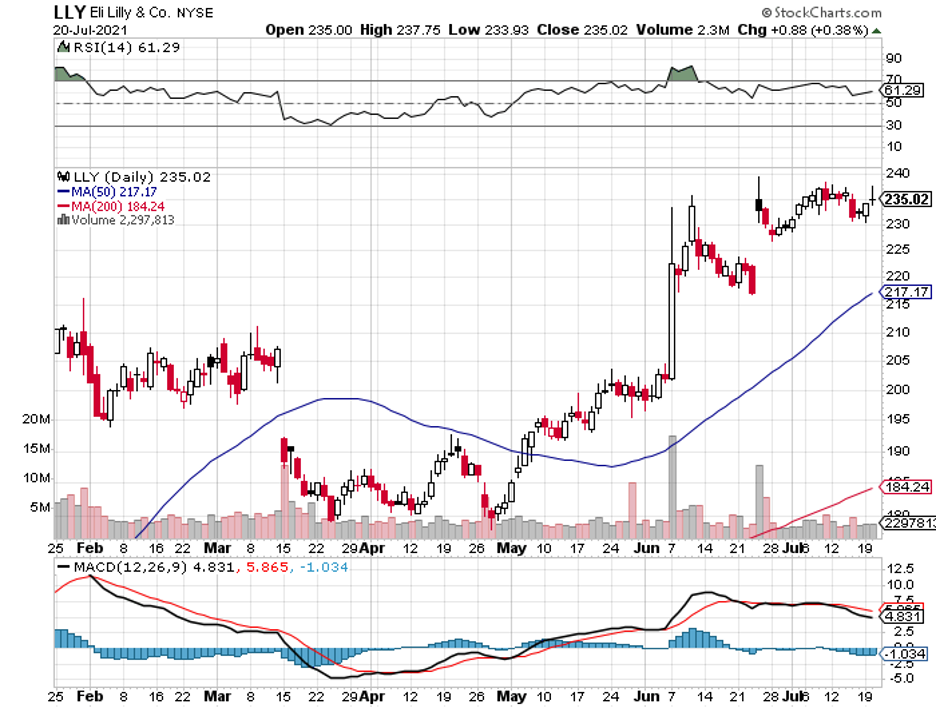
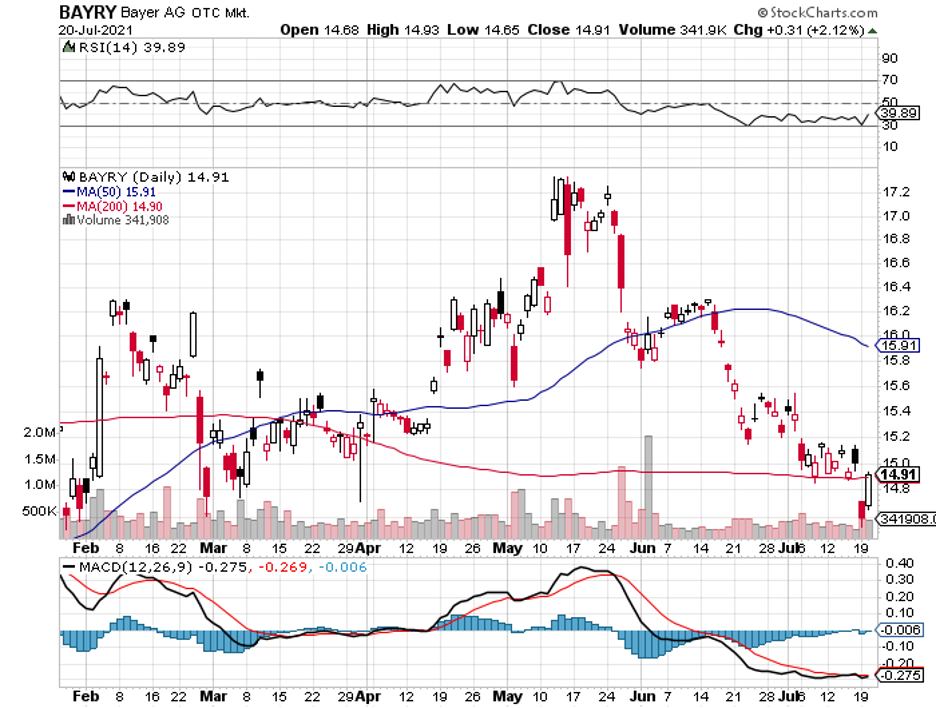
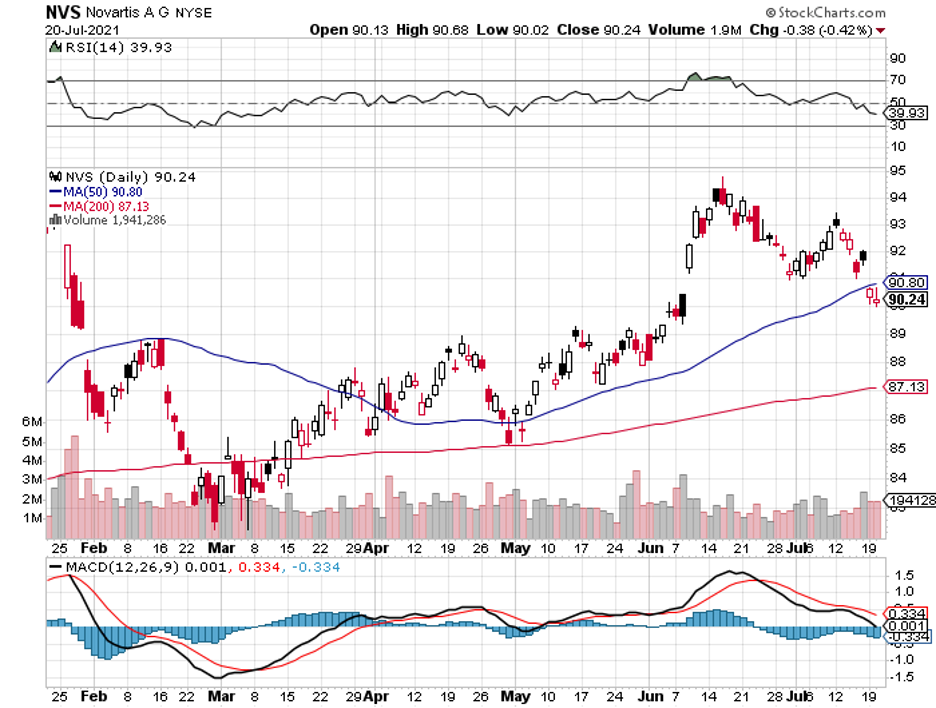
Mad Hedge Biotech & Healthcare Letter
August 19, 2021
Fiat Lux
FEATURED TRADE:
A LOW-PROFILE BIOTECH WINNER
(VRTX), (ACAD), (SRPT), (FGEN), (MRK), (MRNA), (NVS), (XLRN), (PTGX), (IONS), (BLUE), (EDIT), (ABBV)

Choosing winners among biotechnology and healthcare stocks these days isn’t easy.
Since the year started, the sector has been marred with several unexpected disappointments like the 50% decline of crowd favorites Acadia Pharmaceuticals (ACAD) and Sarepta Therapeutics as well as the 33% fall of the ever-dependable FibroGen (FGEN).
So, how can investors pick a winner?
One tactic is taking a peek at what Wall Street analysts are doing, noting which among the companies they’re following are trading the farthest below the estimated price points.
Among the names on the list, a particular stock stands out as a strong contender these days: Vertex Pharmaceuticals (VRTX).
Although it’s one of the most widely known biotechnology companies today, Vertex actually started in a garage of a Harvard-trained chemist, Joshua Bogner, who left his cushy job at one of the most illustrious big pharma companies at that time, Merck (MRK), to pursue his vision.
The company’s raison d’être was a major selling point for a lot of talented and idealistic scientists in that era.
That is, Vertex wanted to find cures for the most challenging diseases and do this in an unbureaucratic setting.
Since then, Vertex’s goal has been straightforward: tackle the most complex and toughest diseases and deliver breakthrough treatments that offer tangible benefits to patients.
Over the years, the company has managed to keep this goal at the forefront of its efforts, starting with its work on the devastating genetic disorder called cystic fibrosis (CF).
Vertex’s work on CF took over a decade, but it eventually led to an impressive franchise that helped with the treatment of patients.
In the first quarter of 2021 alone, sales in this segment reached $1.7 billion.
Expanding on its work, Vertex has explored genetic therapies and set up a collaboration with Moderna (MRNA) in 2016.
Using the latter’s well-established expertise in messenger RNA technology, the companies are expected to come up with more aggressive and advanced CF treatments in the coming years.
Given these developments, Vertex reiterated its 2021 sales guidance to be somewhere in the range of $6.7 and $6.9 billion. Meanwhile, sales of its CF franchise are estimated to peak at $9 to $10 billion—if not higher—by 2024.
Aside from its work on CF, Vertex has also been pouring resources on developing treatments for severe sickle cell anemia and beta thalassemia, a rare blood disorder.
In fact, the company has been looking into these developments as the next major revenue stream, as seen in its bolstered collaboration deal with CRISPR Therapeutics (CRSP).
In this deal, Vertex paid the smaller biotechnology company $900 million upfront plus a potential addition of $200 million following the first regulatory approval of their therapy, CTX001.
While this may sound like a hefty deal to some, Vertex actually values CTX001 at roughly $11 billion.
CTX001, which is a one-time therapy, is priced at roughly $1 million per patient. At this point, the market for beta thalassemia is valued at $32 billion.
Needless to say, this would make CTX001 a massive income generator in the next few years.
Considering the lucrative market for beta thalassemia, though, it’s no surprise that several competitors have emerged to grab their share as well.
Some companies, such as Novartis (NVS) and Acceleron (XLRN), offer maintenance drugs for the disease.
Meanwhile, others like Protagonist Therapeutics (PTGX) and Ionis Pharmaceuticals (IONS) are attempting to develop treatments that would become direct competitors of CTX001.
However, the closest rivals of the Vertex-CRISPR candidate are from Bluebird Bio (BLUE) and Editas Medicine (EDIT).
While this has become a crowded space, Vertex and CRISPR remain the leaders in this segment, as most of the other candidates are still in the investigation phase.
Since it was founded in the 1980s, Vertex has remained true to its vision of tackling some of the toughest diseases out there.
While big pharmaceutical companies, such as AbbVie (ABBV), decided to expand their portfolio through acquisitions, Vertex leveraged its talent pool and maximized its funds by establishing strategic collaborations instead.
This tactic provided the company with enough elbow room that eventually led to its dominance in the CF space, where it now enjoys a virtual monopoly until at least the next decade.
Meanwhile, it has forged strong relationships with promising biotechnology companies and can very well be on its way to becoming the most dominant force in the rare blood disorder segment.
Overall, Vertex Pharmaceuticals is an attractive stock with an impressive portfolio and an even more impressive pipeline.
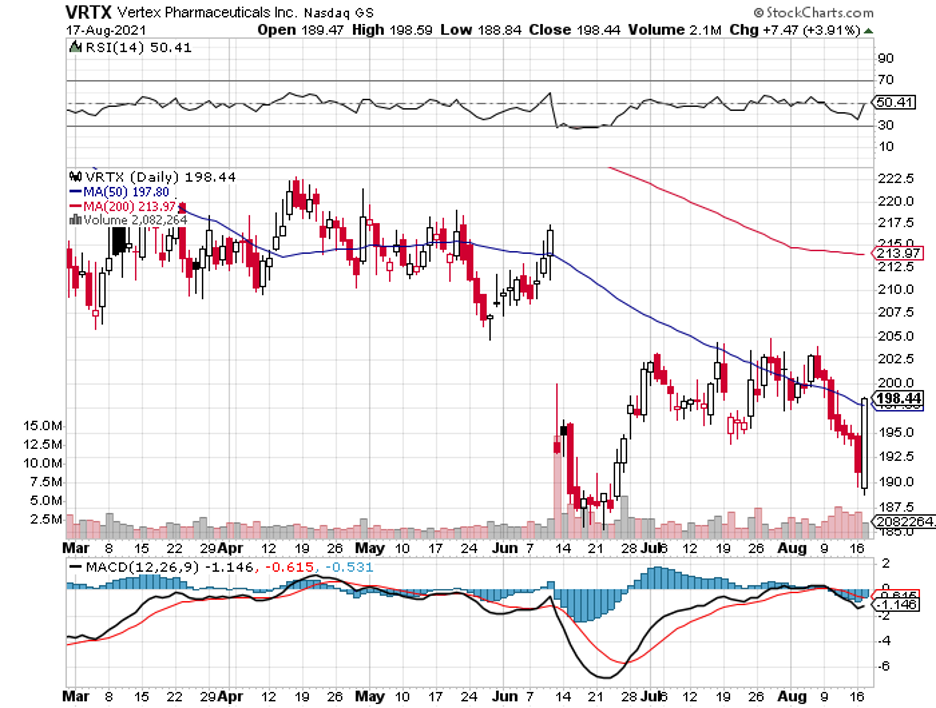
Mad Hedge Biotech & Healthcare Letter
August 10, 2021
Fiat Lux
FEATURED TRADE:
(CLEARING THE SMOKE)
(PM), (GSK), (NVS), (BAYN)

Philip Morris (PM) has long been synonymous with tobacco products, with the company dating all the way back in 1847.
Over 170 years later, though, this $154.6 billion company has gathered and read the tea leaves—and it looks like it finally realized that the future is “smoke-free.”
In a complete about-face, the Marlboro maker is now telling people that it wants to find a cure for heart and lung problems—the very same health conditions people get from tobacco.
Turning from poacher to gamekeeper, Philip Morris has decided to use its widely known expertise in inhalation to improve the health of the people.
One of its major moves towards this decision is to gatecrash the bidding for Vectura, a UK-based contract development and manufacturing company (CDMO) for the healthcare and pharmaceutical industry.
Vectura is known for its expertise and device technology in inhaled products, and the company has been working with numerous companies in the healthcare field, including GlaxoSmithKline (GSK), Novartis (NVS), and Bayer (BAYN).
Basically, Vectura develops treatments and medicines that help manage and cure smoking-related diseases.
So far, Vectura has 13 inhaled medicines along with 11 non-inhaled treatments in the market today.
To date, Philip Morris has raised its offer price to beat out the other contenders bidding for Vectura.
It’s now offering $2.30 per share, with the total reaching roughly $1.4 billion. That puts an almost 45% premium over Vectura’s shares—an offer that experts believe wouldn’t be matched elsewhere.
Considering that Vectura only generated $245 million last year, this is a massive gamble for Philip Morris.
This move comes after Philip Morris acquired Fertin Pharma for $820 million in July.
Fertin is known for developing nicotine chewing gum, lozenges, chewable tablets, and “pouch powders” that quickly dissolve in the user’s mouth.
Considering that Fertin only generated roughly $160 million in sales in 2020, Philip Morris’ move to buy it at that price point also speaks volumes of its plans moving forward.
Although it has yet to wrap up its Vectura acquisition, Philip Morris is not one to wait around.
While waiting for a decision on the British company, it snapped up another respiratory drug development company: OtiTopic.
Founded in 2012, OtiTopic’s main work is focused on Aspirhale, which is a late-stage inhalable acetylsalicylic acid for intermediate to high-risk acute myocardial infarction.
In simpler terms, OtiTopic is working on an inhaled aspirin for heart attacks.
Specifically, Aspirhale works as a dry powder inhalation via a self-administered aerosol.
This is promising since early research indicates that inhaled systems can alleviate the condition in two minutes compared to the 20 minutes needed for chewable aspirin.
With Philip Morris behind it, OtiTopic expects to complete testing soon and file for FDA approval by early 2022.
Considering the massive and expanding market for inhaled therapeutics science, the work of OtiTopic and Philip Morris is estimated to generate at least $1 billion in net revenues by 2025.
Moreover, the tobacco company anticipates the market for inhaled therapeutics will rapidly grow in the next few years and reach as much as $41 billion globally by 2026—a reasonable justification for its decision to splurge on Vectura as well.
When Philip Morris announced that it’ll stop selling cigarettes in the United Kingdom in 10 years, a lot of people thought it’ll be folding up shop.
Truth be told, the company’s about-face to healthcare wasn’t the strongest possibility entertained by the market.
Most believed that it would join forces again with its spinoff, Altria Group (MO), to form a stronger company in the industry and become a powerhouse of smoke-free alternatives.
However, its recent acquisitions indicate that Philip Morris plans to use Fertin, OtiTopic, and Vectura as the core of its legacy business in the healthcare and pharmaceutical industry.
According to Philip Morris, these decisions are part of its "natural evolution into a broader healthcare and wellness company."
While it does feel a bit like an arsonist marketing fire damage insurance, Philip Morris appears to be putting money where its mouth is in terms of transforming itself into a serious life sciences company.
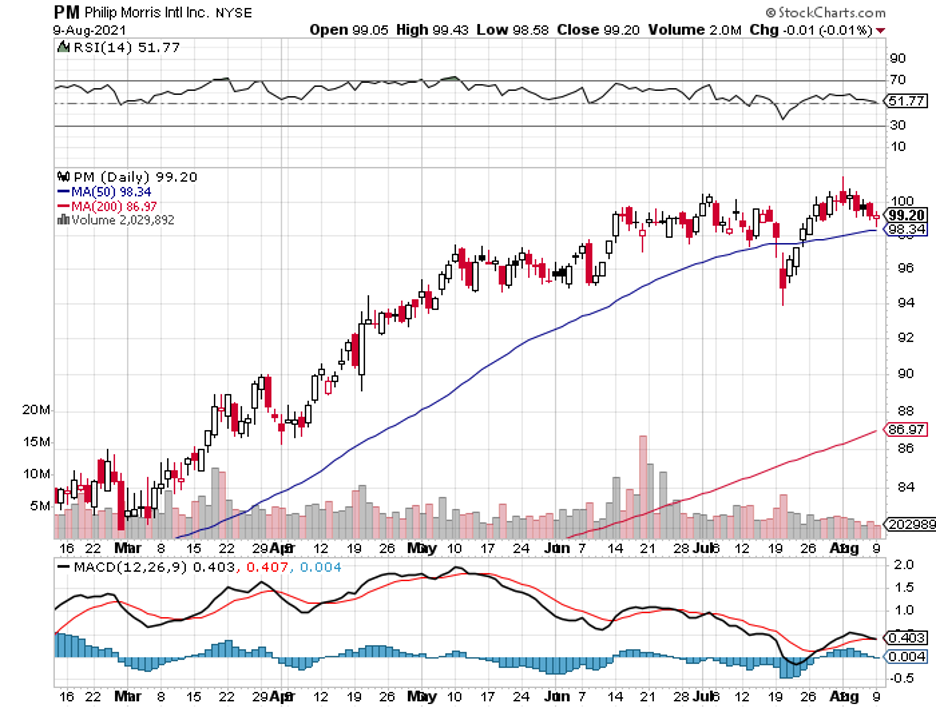
Mad Hedge Biotech & Healthcare Letter
August 3, 2021
Fiat Lux
FEATURED TRADE:
(SHAKING UP THE BIOTECHNOLOGY AND HEALTHCARE INDUSTRY)
(PSTX), (PFE), (NVS), (GILD), (GSK), (BLUE), (CRSP), (EDIT)

With the advancement of biotechnology and healthcare, it’s not hard to imagine a future where drugs and therapies will be tailored to every person’s unique genetic profile.
Thanks to the continuous work on mass customization in the world of pharmaceuticals and even in whole genome sequencing, it’s only a matter of time before we can come up with a personalized pill for each popper.
Nowadays, robotics and automation have started to become tightly integrated with the medical arena. In fact, robotics in the field of pharmaceuticals is no longer anything novel.
The majority of drug manufacturers across the globe are already utilizing robots to address their needs, such as packaging and warehouse storage.
What interests me most, though, is how automation plays an active role in developing actual therapies. After all, doing this entails so much more than simply feeding codes to robots to teach them how to move test tubes around a lab.
One company that has been gaining traction in this space is Multiply Labs. Established in 2016 with roughly $22 million in funding thus far, this San Francisco company aims to be a force multiplier not only in creating personalized pills but also cell therapies.
Run by mostly MIT graduates, Multiply Labs started out by letting their robots take 24-hour shifts to quickly deliver biologic drugs needed for clinical trials.
That offers tremendously faster turnaround times and shorter waiting periods for researchers and pharmaceutical companies.
Since virtually perfecting that process, the company has decided to expand its focus to handle more challenging and complex work.
Now, it has set its sights on using its robotics platform to ease bottlenecks in the development of cell therapies.
As we know, cell therapies are regarded as powerful tools in the battle against cancer. However, the production process is extremely labor-intensive. This makes their development incredibly expensive.
Let’s take CAR-T cell therapy, which boosts the body’s immune system to help it fight off cancer, as an example.
In CAR-T cell therapy, scientists need to extract blood from the patient. Then they’d have to isolate the immune cells, which they would need to genetically engineer.
After that, they have to carefully grow the new cells. Finally, they’d inject these genetically engineered new cells back into the patient.
In most cases, every step needs to be repeated for individual patients.
What Multiply Labs is trying to do is automate several stages, such as genetically altering the harvested cells, which can only be performed by highly trained professionals.
Not only will they be able to cut down on the time needed to complete the procedures, they would also be able to reduce—if not completely eliminate—human error.
Aside from working with the University of California San Francisco, Multiply Labs has been collaborating with Cytiva, a subsidiary of Dannaher (DHR), to move their services closer to commercialization.
Apart from Multiply Labs, another San Francisco company has been working on improving the expensive, logistically complicated, and oftentimes error-filled cell therapy space: Cellares.
Unlike Multiply Labs, which aims to ease the bottleneck in the cell therapy creation process, Cellares’ goal is to handle the entire procedure on its own.
Dubbing its work as the “Cell Shuttle,” what Cellares offers is basically a “factory in a box” solution to the creators of cell therapies.
Basically, the “Cell Shuttle” is an end-to-end solution that comes in the form of a box designed to deliver an automated cell therapy platform. Cellares’ product handles everything from beginning to end, starting from taking in the cells of the patient to injecting the genetically engineered versions back into the individual.
Raking in roughly $100 million in funding so far, Cellares’ plan is to allow the pharmaceutical companies to scale and deploy the “Cell Shuttle” based on their needs.
To date, Cellares’ latest collaborator in this venture is Poseida Therapeutics (PSTX).
However, there are thousands of cell-based and cell therapy clinical studies conducted across the globe. The cell and gene therapy (CGT) sector is projected to be one of the fastest-growing markets in the healthcare sector, with the segment estimated to reach $14 billion by 2025.
Moreover, CGT offers promising treatments for severe and chronic conditions like obesity, diabetes, and, of course, cancer. It can also be the answer to rare genetic conditions and their related complications.
That’s why it comes as no surprise that Big Pharma names like Pfizer (PFE), Novartis (NVS), Gilead Sciences (GILD), and GlaxoSmithKline (GSK) are taking interest in this niche.
However, the progress of smaller companies, such as bluebird Bio (BLUE), CRISPR Therapeutics (CRSP), and Editas Medicine (EDIT), also offers incredible potential in this space.
And while Poseida Therapeutics may be the first to collaborate with the likes of Cellares and Multiply Labs, the rest would undoubtedly follow suit in integrating robotics and healthcare in the near future.
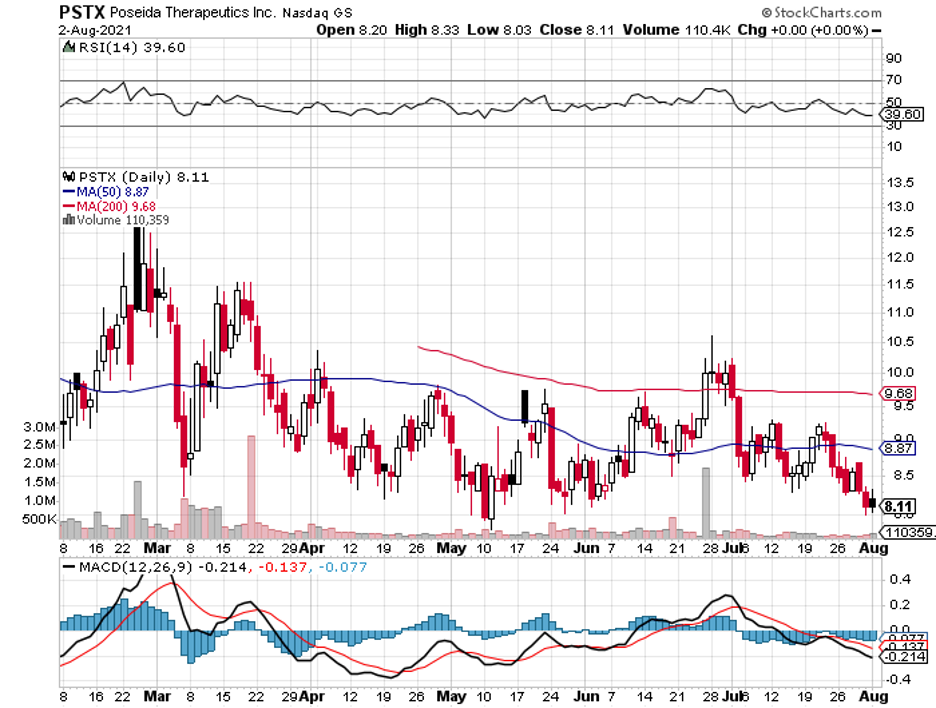
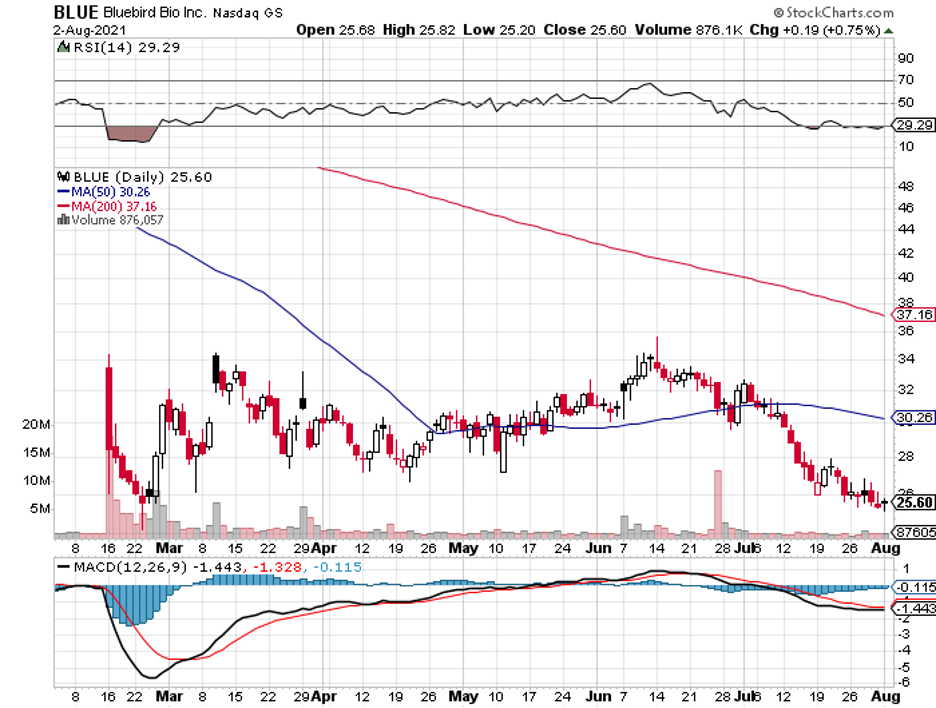
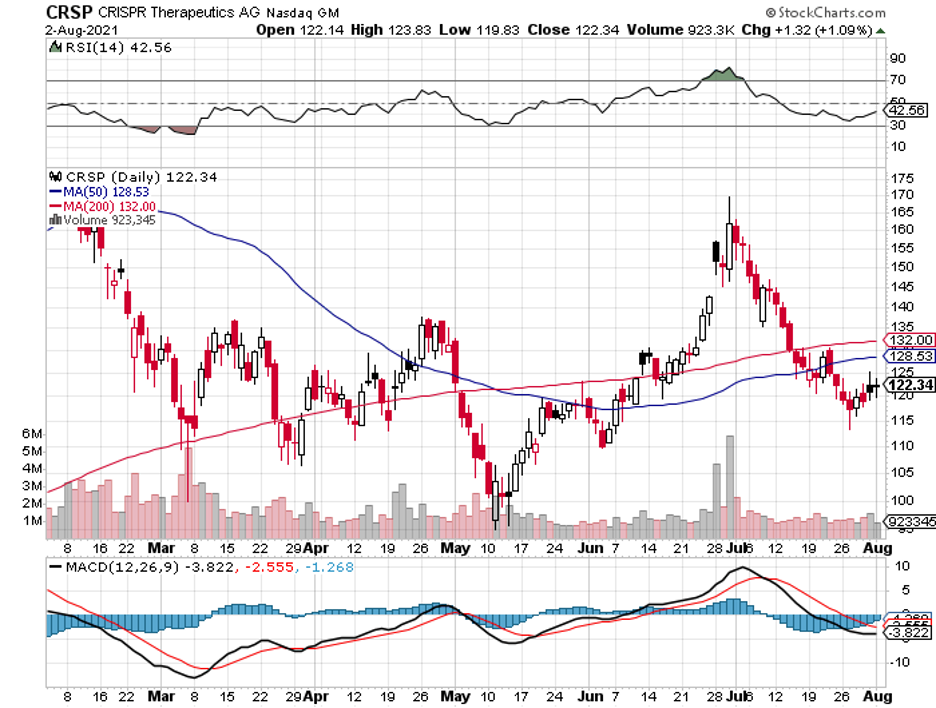
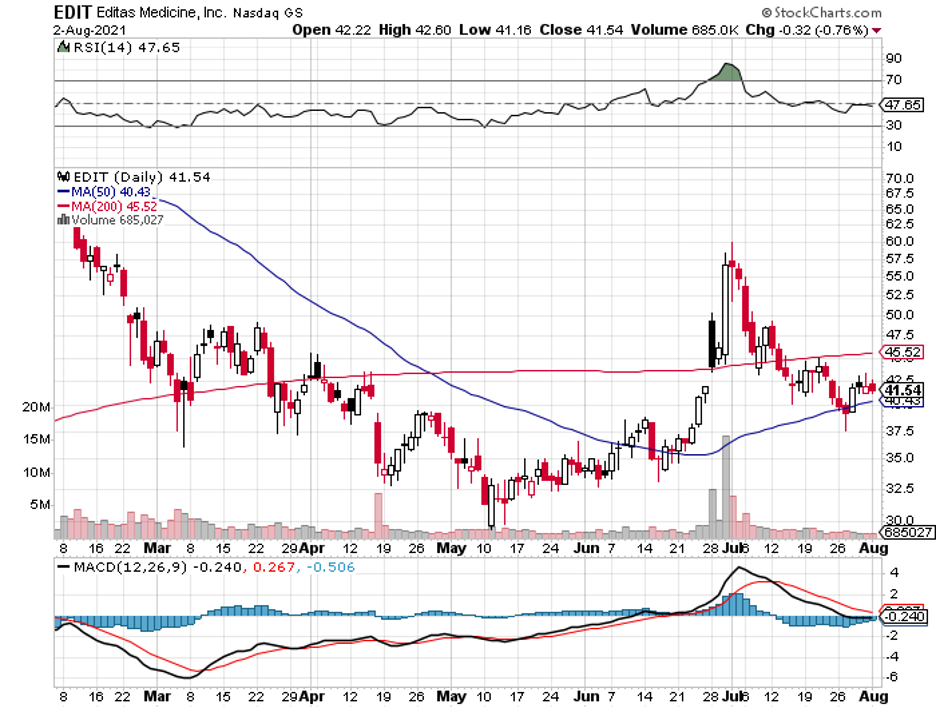
Legal Disclaimer
There is a very high degree of risk involved in trading. Past results are not indicative of future returns. MadHedgeFundTrader.com and all individuals affiliated with this site assume no responsibilities for your trading and investment results. The indicators, strategies, columns, articles and all other features are for educational purposes only and should not be construed as investment advice. Information for futures trading observations are obtained from sources believed to be reliable, but we do not warrant its completeness or accuracy, or warrant any results from the use of the information. Your use of the trading observations is entirely at your own risk and it is your sole responsibility to evaluate the accuracy, completeness and usefulness of the information. You must assess the risk of any trade with your broker and make your own independent decisions regarding any securities mentioned herein. Affiliates of MadHedgeFundTrader.com may have a position or effect transactions in the securities described herein (or options thereon) and/or otherwise employ trading strategies that may be consistent or inconsistent with the provided strategies.
This site uses cookies. By continuing to browse the site, you are agreeing to our use of cookies.
OKLearn moreWe may request cookies to be set on your device. We use cookies to let us know when you visit our websites, how you interact with us, to enrich your user experience, and to customize your relationship with our website.
Click on the different category headings to find out more. You can also change some of your preferences. Note that blocking some types of cookies may impact your experience on our websites and the services we are able to offer.
These cookies are strictly necessary to provide you with services available through our website and to use some of its features.
Because these cookies are strictly necessary to deliver the website, refuseing them will have impact how our site functions. You always can block or delete cookies by changing your browser settings and force blocking all cookies on this website. But this will always prompt you to accept/refuse cookies when revisiting our site.
We fully respect if you want to refuse cookies but to avoid asking you again and again kindly allow us to store a cookie for that. You are free to opt out any time or opt in for other cookies to get a better experience. If you refuse cookies we will remove all set cookies in our domain.
We provide you with a list of stored cookies on your computer in our domain so you can check what we stored. Due to security reasons we are not able to show or modify cookies from other domains. You can check these in your browser security settings.
These cookies collect information that is used either in aggregate form to help us understand how our website is being used or how effective our marketing campaigns are, or to help us customize our website and application for you in order to enhance your experience.
If you do not want that we track your visist to our site you can disable tracking in your browser here:
We also use different external services like Google Webfonts, Google Maps, and external Video providers. Since these providers may collect personal data like your IP address we allow you to block them here. Please be aware that this might heavily reduce the functionality and appearance of our site. Changes will take effect once you reload the page.
Google Webfont Settings:
Google Map Settings:
Vimeo and Youtube video embeds:
